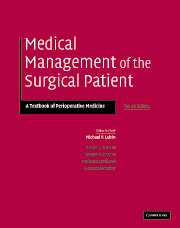Book contents
- Frontmatter
- Contents
- Editor biographies
- List of contributors
- Preface
- Introduction
- Part I Medical management
- 1 Anesthesia management of the surgical patient
- 2 Nutrition
- 3 Preoperative testing
- 4 Chronic medications around the time of surgery
- 5 Ethical considerations in the surgical patient
- 6 Cardiovascular disease
- 7 Postoperative chest pain and shortness of breath
- 8 Perioperative management of hypertension
- 9 Perioperative pulmonary risk evaluation and management for non-cardiothoracic surgery
- 10 Acute lung injury (ALI) and the acute respiratory distress syndrome (ARDS)
- 11 Postoperative pulmonary complications
- 12 Peptic ulcer disease
- 13 Liver disease
- 14 Inflammatory bowel disease
- 15 Postoperative gastrointestinal complications
- 16 Disorders of red cells
- 17 Assessment of bleeding risk in the patient with no history of hemostatic problems
- 18 Surgical issues affecting patients with hemotologic malignancies
- 19 Prophylaxis for deep venous thrombosis and pulmonary embolism in surgery
- 20 Blood transfusion/preoperative considerations and complications
- 21 Prevention of surgical site infections
- 22 Medical care of the HIV-infected surgical patient
- 23 Fever and infection in the postoperative setting
- 24 Surgery in the patient with renal disease
- 25 Postoperative electrolyte disorders
- 26 Diabetes mellitus
- 27 Disorders of the thyroid
- 28 Disorders of the adrenal cortex
- 29 Disorders of calcium metabolism
- 30 Pheochromocytoma
- 31 Rheumatologic diseases
- 32 Cerebrovascular disease
- 33 Management of the surgical patient with dementia
- 34 Neuromuscular disorders
- 35 Perioperative management of patients with Parkinson's disease
- 36 Delirium in the surgical patient
- 37 Surgery in the elderly
- 38 Obesity
- 39 Depression
- 40 Substance abuse
- 41 Care of the peripartum patient
- Part II Surgical procedures and their complications
- Index
- References
26 - Diabetes mellitus
Published online by Cambridge University Press: 12 January 2010
- Frontmatter
- Contents
- Editor biographies
- List of contributors
- Preface
- Introduction
- Part I Medical management
- 1 Anesthesia management of the surgical patient
- 2 Nutrition
- 3 Preoperative testing
- 4 Chronic medications around the time of surgery
- 5 Ethical considerations in the surgical patient
- 6 Cardiovascular disease
- 7 Postoperative chest pain and shortness of breath
- 8 Perioperative management of hypertension
- 9 Perioperative pulmonary risk evaluation and management for non-cardiothoracic surgery
- 10 Acute lung injury (ALI) and the acute respiratory distress syndrome (ARDS)
- 11 Postoperative pulmonary complications
- 12 Peptic ulcer disease
- 13 Liver disease
- 14 Inflammatory bowel disease
- 15 Postoperative gastrointestinal complications
- 16 Disorders of red cells
- 17 Assessment of bleeding risk in the patient with no history of hemostatic problems
- 18 Surgical issues affecting patients with hemotologic malignancies
- 19 Prophylaxis for deep venous thrombosis and pulmonary embolism in surgery
- 20 Blood transfusion/preoperative considerations and complications
- 21 Prevention of surgical site infections
- 22 Medical care of the HIV-infected surgical patient
- 23 Fever and infection in the postoperative setting
- 24 Surgery in the patient with renal disease
- 25 Postoperative electrolyte disorders
- 26 Diabetes mellitus
- 27 Disorders of the thyroid
- 28 Disorders of the adrenal cortex
- 29 Disorders of calcium metabolism
- 30 Pheochromocytoma
- 31 Rheumatologic diseases
- 32 Cerebrovascular disease
- 33 Management of the surgical patient with dementia
- 34 Neuromuscular disorders
- 35 Perioperative management of patients with Parkinson's disease
- 36 Delirium in the surgical patient
- 37 Surgery in the elderly
- 38 Obesity
- 39 Depression
- 40 Substance abuse
- 41 Care of the peripartum patient
- Part II Surgical procedures and their complications
- Index
- References
Summary
Surgery has major effects on carbohydrate metabolism and thus presents special risks for patients with diabetes. Surgical mortality rates for patients with diabetes have declined but the successful perioperative care of these patients requires close cooperation between surgeons, anesthesiologists, and primary physicians to prevent complications. More than 20 million people in the USA have diabetes and at least half of them will require surgery at some point in their lives. In addition to surgical conditions typical of the general population, patients with diabetes experience increased intervention for occlusive vascular disease; cholelithiasis; ophthalmic disease (i.e., cataract extraction, vitrectomy); renal disease; and infection. Three of four patients with diabetes are older than 40 years and are approaching a time of life when surgical indications increase. The presence of diabetes typically is known before operation, although a new diagnosis of diabetes is made in the perioperative period in as many as 20% of cases.
Pathophysiology
The endocrine pancreas, which consists of the islets of Langerhans, accounts for less than 3% of the total pancreatic mass in adults. The islets are unevenly distributed through the pancreas and contain four cell types: A (α) cells, which secrete glucagons; B (β) cells, which secrete insulin; D (δ) cells, which secrete somatostatin; and F cells, which secrete pancreatic polypeptide. Insulin, the major secretory product, is synthesized as a precursor molecule, preproinsulin, in the endoplasmic reticulum and is cleaved by microsomal enzymes to proinsulin. Proinsulin is then converted by proteolysis to insulin and an amino acid residue, c-peptide.
- Type
- Chapter
- Information
- Medical Management of the Surgical PatientA Textbook of Perioperative Medicine, pp. 361 - 366Publisher: Cambridge University PressPrint publication year: 2006

